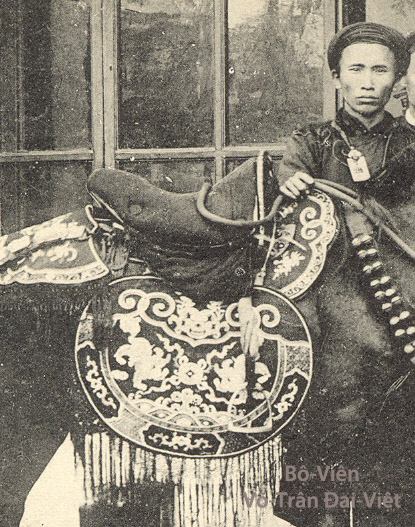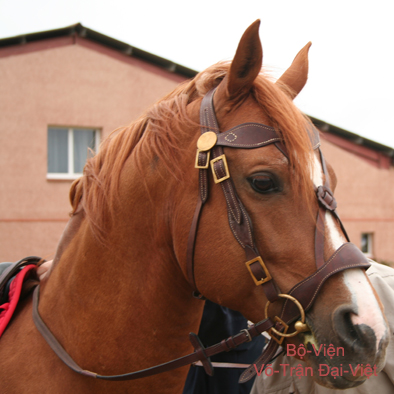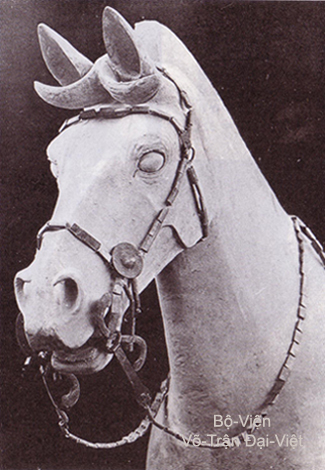II.
The Medieval Military Horses Driving
2 - The Harnessing
The Military Horse Driving study request a Harnessing compatible with the wielding of medieval arms from Eighteen sections Martial Arts.
The vietnamese adage : « The Silk makes more attractive Man, the Saddle makes more attactive the Horse » takes on a meaning stil more sustained in Military Horse Driving because the War Horse requires a War Saddle and a Bridle for manifesting itself on battle fields. In the bygone days, more the Dignity was highest-ranking, more the Harness was magnificent and sumptuous.
A - The Various Elements of War Saddle ( Yên-Trận 鞍 陣 ) :
The « War Saddle » ( Yên-Trận 鞍 陣 ) is made up of fourteen parts following :
01. « The Seat » (Bàn-Tọa 盤 座 ) - sometimes wraped in embroidered silk cover callled « Yên-Cân » ( 鞍 巾 ) or well « Thế » ( 屜 ) ;
02. « The Pommel » (Tiền-Kiều 前 橋), still called « Tiền-Luân » ( 前 輪 ) - it's the anterior part of saddle situated at the level of the withers and using to protect the lower abdomen of cavalryman ;
03. « The Cantle » (Hậu-Kiều 後 橋), called in bygone days « Hậu-Luân » ( 後 輪 ) - it's the posterior part of saddle for protecting the backside of cavalryman and for using as support to increase the power during the combat ;
04. « The Tail cover » (Vỹ-Đại 尾 袋 ), it's a cover to prevent the horse's tail from being tangled up in the blades of medieval weapons during their wielding ;
05. « The Tasseled Breastpiece » ( Hung-Huyền 胸 懸 ), still called briefly « Ưởng » ( 鞅 ) - it's a leather strap fastening the saddle at the chest's horse for preventing the saddle from being slipped into backwards during the climb up a slope, or during the parries of too violent opposite attacks coming from forwards ;
06. « The Croup Piece » ( Hậu-Thu 後 鞦 ), still called briefly « Thu » ( 鞦 ), but called in bygone days « Khào-Hệ » (尻 繋) - it's the leather strap fastening the saddle at the roof of the horse tail for preventing the saddle from being slipped into forwards , or during the parades of too violent opposite attacks coming from backwards ;
07. « The Fender » ( Chướng-Nê 障 泥 ), still called illogically « Reins Protector » ( Hộ-Lạc 護 絡 ) ;
08. « The Girth » ( Phúc-Đai 腹 帯 ), still called « Đỗ-Đai » ( 肚 帶 ) ;
09. « The Stirrup Bar » ( Đặng Đai Huyền 鐙 帶 縣 ) ;
10. « Entire-sole Stirrups » ( Đặng 鐙 ), still called in Nôm by « Chân Đâng » ;
11. « The Stirrups Leather (Mã-Đặng Bì-Đai 馬 鐙 皮 帶 ), called in Nôm by « Giây Chân Đâng », and called in japanese by « Chikaragawa - Lực-Cách 力 革 » ;
12. « The Upper-Saddlepad » ( Thiết-Phó 切 付 ), still called « Trảm-Phó » ( 斬 付) ;
13. « The Lower-Saddlepad » ( Cơ-Phó 肌 付 ), still called « Mã-Nhục » ( 馬 褥 ) ;
14. « The Hindquarters Net » ( Hậu-Thu Võng 後 鞦 網 ), still called « Avaloire » - that's the Net (Võng) putting on the horse hindquarters and attached to the Croup-Piece (Hậu-Thu 後 鞦) and the Cantle as well as to the Fender (Chướng-Nê 障 泥) on each side of the horse flank.
Modern War Saddle equipped with brass Rings for being able |
War Saddle under Nguyễn Dynasty |
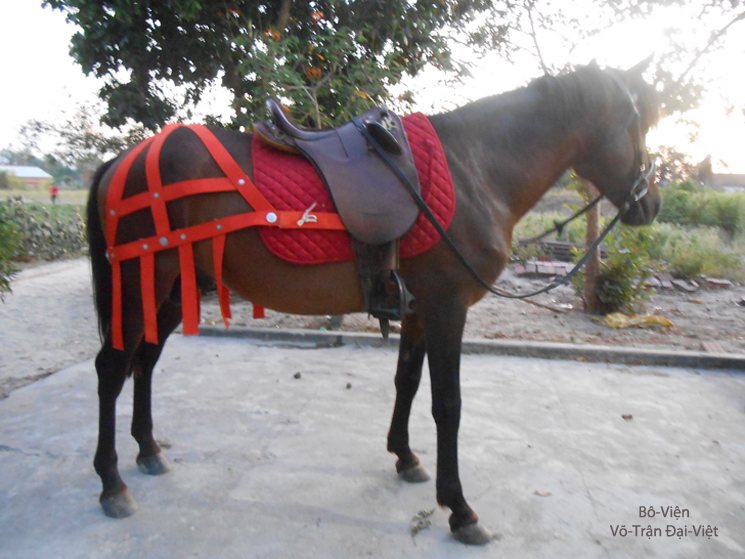
Battle Saddle designed for War Horse with Avaloire (Hindquarters Net).
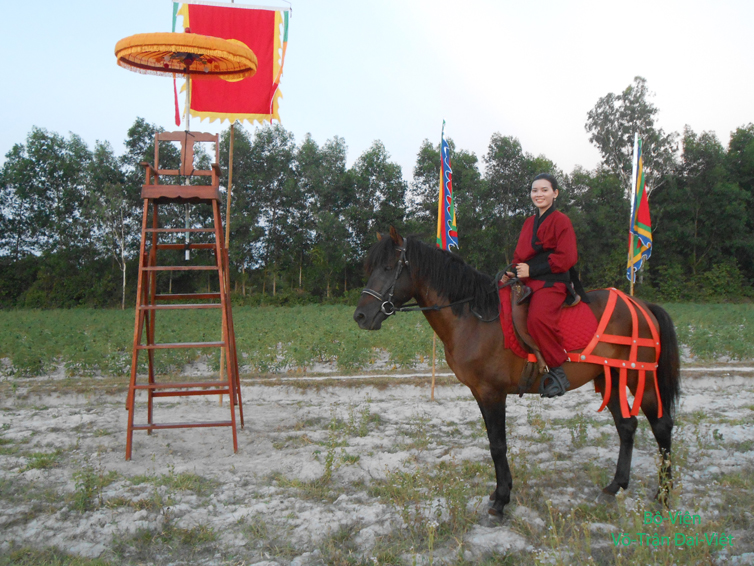
Schooling to get war horse « Thần-Phong »
(Divine Wind)
used to Avaloire (Hindquarters Net - Hậu-Thu-Võng - 後 鞦 網 )
in the new Martial Training Area of V.T.Đ.V.
B - The Various Elements of the Bridle ( Mã-Lặc 馬 絡 ) :
The Bridle is made up of seven parts following :
01. « The Headstall connector » ( Lập-Văn 立 聞 ) ;
02. « The Cheekpiece » ( Mã-Bí 馬 轡 ) ;
03. « The Bit » ( Mã-Hàm 馬 銜 ), still called briefly « Hàm » ( 銜 ) ;
04. « The Browband » ( Mã-Đề 馬 題 ) ;
05. « The Throatlash » ( Lung Đầu 籠 頭 ), called in bygone days « Thủ-Huyền » ( 面 繋), or « Mã-Trụ » (馬 紂) ;
06. « The Headstall » ( Diện-Huyền 面 懸 ), still called « Diện-Hệ » ( 面 繫) ;
07. « The Reins » ( Cương-Thằng 綱 繩 ), called in Nôm by « Giây Cương = Straps of Reins », and called in days of old by « Thủ-Cương = The Hand Reins » (手 綱).
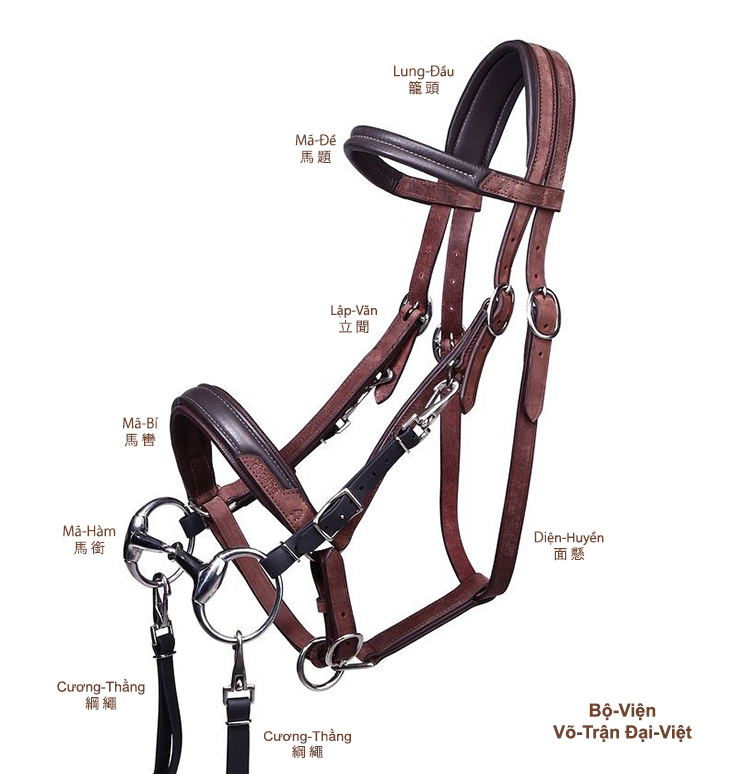
The Bridle
Mã-Lặc - 馬 絡.
Modern Period Harnessing Bridle
|
Antique Harness Bridle under Tần (Qin) Dynasty |
Committee of TRỊNH Quang Thắng |
1 – The Choice of War Horses
2 – The Harnessing
3 – The Horses Riding Exercises
4 – The Training for Horseback Medieval Weapons Wielding
Bibliography :
« Annamite-Français Dictionary » from J.F.M. GENIBREL, Ed.1898.
« Vietnamien-Chinois-Français Dictionary » from Eugène GOUIN, Ed.1957.
« Việt-Nam Dictionary » (Việt-Nam Tự Điển) » from "Ban Văn-Học Hội Khai-Trí Tiến-Đức Khởi-Thảo", Ed. 1931
« Comments from a LiIbrary » ("Vân Ðài Loại-Ngữ") from Lê-Quí-Ðôn, Ed. 1773.
Copyright © 2004 - 2018 by ACFDV - All rights reserved.

